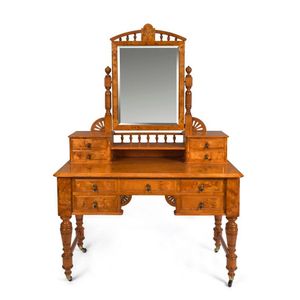Colonial Huon Pine Dressing Table - Victorian Era
A fine Colonial huon pine dressing table, Melbourne, Victorian origin, circa 1885, 182 cm high, 122 cm wide, 60 cm deep
You must be a subscriber, and be logged in to view price and dealer details.
Subscribe Now to view actual auction price for this item
When you subscribe, you have the option of setting the currency in which to display prices to $Au, $US, $NZ or Stg.
This item has been sold, and the description, image and price are for reference purposes only.
- Huon Pine - Named after the Frenchman who discovered the Huon River in Tasmania, it is an extremely slow growing and long living tree. Huon pine is native to Tasmania, and it can grow to an age of 3,000 years or more. The wood contains oil that retards the growth of fungi, hence its early popularity in ship-building in convict-era Tasmania. The timber is a warm yellow colour, finely grained, and was popular for household furniture in the Victorian era. Interestingly, much Huon pine furniture was made in South Australia. Huon pine is a protected species and only limited quantities are available nowadays, for craftsmen to manufacture small items such as platters, sculptures and other decorative objects.
- Circa - A Latin term meaning 'about', often used in the antique trade to give an approximate date for the piece, usually considered to be five years on either side of the circa year. Thus, circa 1900 means the piece was made about 1900, probably between 1895 and 1905. The expression is sometimes abbreviated to c.1900.
- Victorian Period - The Victorian period of furniture and decorative arts design covers the reign of Queen Victoria from 1837 to 1901. There was not one dominant style of furniture in the Victorian period. Designers used and modified many historical styles such as Gothic, Tudor, Elizabethan, English Rococo, Neoclassical and others, although use of some styles, such as English Rococo and Gothic tended to dominate the furniture manufacture of the period.
The Victorian period was preceded by the Regency and William IV periods, and followed by the Edwardian period, named for Edward VII (1841 ? 1910) who was King of the United Kingdom and the British Dominions and Emperor of India for the brief period from 1901 until his death in 1910.
This item has been included into following indexes:
